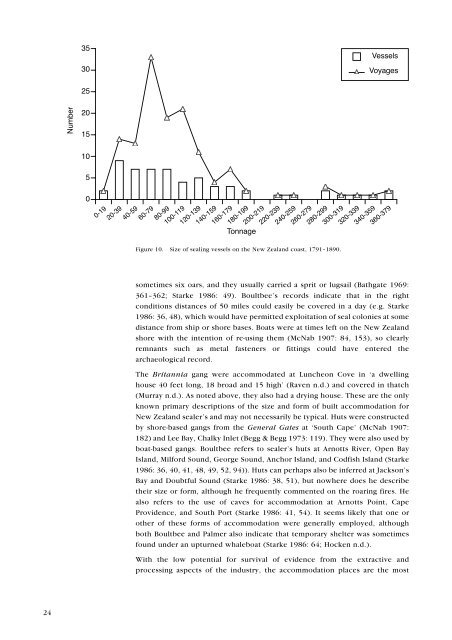The New Zealand Sealing Industry - Department of Conservation
The New Zealand Sealing Industry - Department of Conservation
The New Zealand Sealing Industry - Department of Conservation
You also want an ePaper? Increase the reach of your titles
YUMPU automatically turns print PDFs into web optimized ePapers that Google loves.
Figure 10. Size <strong>of</strong> sealing vessels on the <strong>New</strong> <strong>Zealand</strong> coast, 1791–1890.<br />
sometimes six oars, and they usually carried a sprit or lugsail (Bathgate 1969:<br />
361–362; Starke 1986: 49). Boultbee’s records indicate that in the right<br />
conditions distances <strong>of</strong> 50 miles could easily be covered in a day (e.g. Starke<br />
1986: 36, 48), which would have permitted exploitation <strong>of</strong> seal colonies at some<br />
distance from ship or shore bases. Boats were at times left on the <strong>New</strong> <strong>Zealand</strong><br />
shore with the intention <strong>of</strong> re-using them (McNab 1907: 84, 153), so clearly<br />
remnants such as metal fasteners or fittings could have entered the<br />
archaeological record.<br />
<strong>The</strong> Britannia gang were accommodated at Luncheon Cove in ‘a dwelling<br />
house 40 feet long, 18 broad and 15 high’ (Raven n.d.) and covered in thatch<br />
(Murray n.d.). As noted above, they also had a drying house. <strong>The</strong>se are the only<br />
known primary descriptions <strong>of</strong> the size and form <strong>of</strong> built accommodation for<br />
<strong>New</strong> <strong>Zealand</strong> sealer’s and may not necessarily be typical. Huts were constructed<br />
by shore-based gangs from the General Gates at ‘South Cape’ (McNab 1907:<br />
182) and Lee Bay, Chalky Inlet (Begg & Begg 1973: 119). <strong>The</strong>y were also used by<br />
boat-based gangs. Boultbee refers to sealer’s huts at Arnotts River, Open Bay<br />
Island, Milford Sound, George Sound, Anchor Island, and Codfish Island (Starke<br />
1986: 36, 40, 41, 48, 49, 52, 94)). Huts can perhaps also be inferred at Jackson’s<br />
Bay and Doubtful Sound (Starke 1986: 38, 51), but nowhere does he describe<br />
their size or form, although he frequently commented on the roaring fires. He<br />
also refers to the use <strong>of</strong> caves for accommodation at Arnotts Point, Cape<br />
Providence, and South Port (Starke 1986: 41, 54). It seems likely that one or<br />
other <strong>of</strong> these forms <strong>of</strong> accommodation were generally employed, although<br />
both Boultbee and Palmer also indicate that temporary shelter was sometimes<br />
found under an upturned whaleboat (Starke 1986: 64; Hocken n.d.).<br />
With the low potential for survival <strong>of</strong> evidence from the extractive and<br />
processing aspects <strong>of</strong> the industry, the accommodation places are the most<br />
24
















